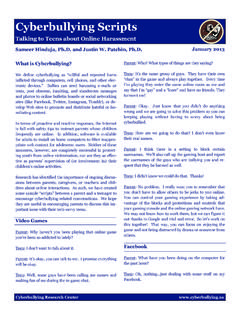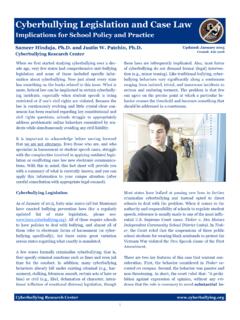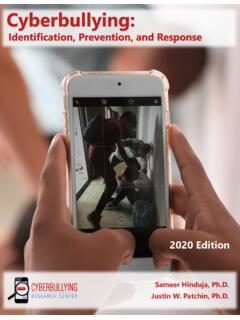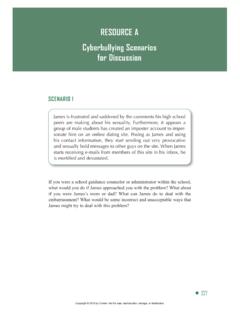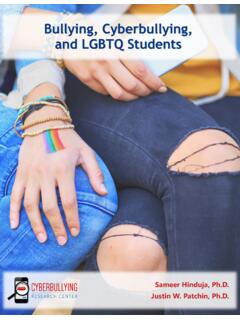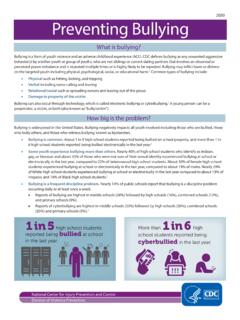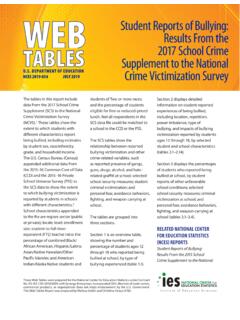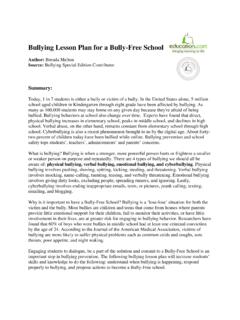Transcription of Cyberbullying Research Summary
1 Sameer Hinduja, and Justin W. Patchin, Cyberbullying Research Center outh suicide continues to be a significant public health concern in the United States. Even though suicide rates have decreased percent among young people in recent years, upward trends were identified in the 10- to 19-year-old age In addition to those who successfully end their life, many other adolescents strongly think about and even attempt suicide. One factor that has been linked to suicidal ideation is experience with bullying . That is, youth who are bullied, or who bully others, are at an elevated risk for suicidal thoughts, attempts, and completed , 3 The reality of these links has been strengthened through Research showing how experience with peer harassment (most often as a target but also as a perpetrator) contributes to depression, decreased self-worth, hopelessness, and loneliness all of which are precursors to suicidal thoughts and Without question, the nature of adolescent peer aggression has evolved due to the proliferation of information and communications technology.
2 There have been several high-profile cases involving teenagers taking their own lives in part because of being harassed and mistreated over the Internet,7-9 a phenomenon we have termed cyberbullicide suicide indirectly or directly influenced by experiences with online While these incidents are isolated and do not represent the norm, their gravity demands deeper inquiry and understanding. Much Research has been conducted to determine the relationship between traditional bullying and suicidal ideation, and it can be said with confidence that a strong relationship , 12 Based on what we found in the extant literature base, we sought to determine if suicidal ideation was also linked to experiences with Cyberbullying among offenders and targets. Results In our recent Research involving approximately 2,000 randomly-selected middle-schoolers from one of the most populous school districts in the United States, 20% of respondents reported seriously thinking about attempting suicide ( of females; of males), while 19% reported attempting suicide ( of females; of males).
3 This is comparable to other studies focusing on adolescent With regard to traditional bullying , prevalence rates for individual behaviors ranged from to for offending and from to for victimization. The most common form of bullying offending reported by respondents was: I called another student mean names, made fun of or teased him or her in a hurtful way ( ), while the most frequently-cited form of bullying victimization was: Other students told lies or spread false rumors about me and tried to make others dislike me ( ). With regard to Cyberbullying , prevalence rates for individual behaviors ranged from to for offending and from to for victimization. The most commonly-reported form of Cyberbullying offending was: Posted something online about another person to make others laugh ( ) while the most frequent form of victimization was: Received an upsetting email from someone you know ( ).
4 With respect to bullying , all forms were significantly associated with increases in suicidal ideation among sample respondents. That is, youth who experienced traditional bullying or Cyberbullying , as either an offender or a victim, scored higher on our suicidal ideation scale than those who had not experienced those two forms of peer aggression. Moreover, it appears that bullying and Cyberbullying victimization was a stronger predictor of suicidal thoughts and behaviors than was bullying and Cyberbullying offending. Finally, we wanted to see if bullying and Cyberbullying experiences were related to an increased likelihood of an adolescent attempting suicide. Results showed that all forms of peer aggression increased the likelihood that the respondent attempted suicide. Traditional bullying victims were times more likely and traditional bullying offenders were times more likely to have attempted Y Cyberbullying Research Summary Cyberbullying and Suicide Highlights from the Research : 20% of respondents reported seriously thinking about attempting suicide All forms of bullying were significantly associated with increases in suicidal ideation Cyberbullying victims were almost twice as likely to have attempted suicide compared to youth who had not experienced Cyberbullying C y b e r b u l l y i n g R e s e a r c h S u m m a r y 2 suicide than those who were not traditional victims or offenders.
5 Similarly, Cyberbullying victims were times more likely and Cyberbullying offenders were times more likely to have attempted suicide than those who were not Cyberbullying victims or offenders. Discussion The small but significant variation found in suicidal thoughts and actions based on bullying and Cyberbullying suggests that all forms of adolescent peer aggression must be taken seriously - both at school and at home. As such, psychologists, counselors, and parents must continually monitor the online and offline behaviors of youth to reinforce the good and regulate the bad. In addition, the findings suggest that a suicide prevention and intervention component is essential within comprehensive bullying response programs implemented in schools. Without question, the topic is sensitive and its presentation should be age-appropriate, as students in all grade levels must understand the serious consequences associated with peer aggression.
6 While suicide is an extreme response, proper discussion of its stark reality can vividly portray the extent of harm that peer harassment can exact. It should be acknowledged that many of the teenagers who committed suicide after experiencing bullying or Cyberbullying had other emotional and social issues going on in their lives. For example, one cyberbullicide victim attended special education classes in elementary school and struggled socially and Another suffered from low self-esteem and depression and was on medication when she took her As mentioned earlier, it is unlikely that experience with Cyberbullying by itself leads to youth suicide. Rather, it tends to exacerbate instability and hopelessness in the minds of adolescents already struggling with stressful life Future Research should identify and specifically assess the contributive nature of these stress-inducing experiences.
7 Note: This Fact Sheet is an abbreviated version of a full-length journal article entitled bullying , Cyberbullying , and Suicide which was published in the journal Archives of Suicide Research . Suggested citation: Hinduja, S. & Patchin, J. W. (2010). bullying , Cyberbullying , and Suicide. Archives of Suicide Research , 14(3), 206-221. NOTES: 1. Centers for Disease Control and Prevention. Morbidity and Mortality Weekly Report, 56(35), 905 908. Suicide Trends Among Youths and Young Adults Aged 10-24 Years -- United States, 1990-2004 [ Accessed December 20, 2007. 2. van der Wal MF, de Wit CAM, Hirasing RA. Psychosocial health among young victims and offenders of direct and indirect bullying . Pediatrics. 2003;111:1312-1317. 3. Rigby K, Slee PT. Suicidal ideation among adolescent school children, involvement in bully-victim problems, and perceived social support. Suicide and Life Threatening Behavior.]
8 1999;29(2):119-130. 4. Joiner TEJ, Rudd MD. Disentangling the interrelations between hopelessness, loneliness, and suicidal ideation. Suicide and Life-Threatening Behavior. 1996;26:19-26. 5. Kaltiala-Heino R, Rimpela M, Rantanen P, Rimpela A. bullying at school - an indicator of adolescents at risk for mental disorders. Journal of Adolescence. 2000;23:661-674. 6. Hawker DSJ, Boulton MJ. Twenty years Research on peer victimization and psychological maladjustment: A meta-analysis review of cross-sectional studies. Journal of Child Psychology and Psychiatry. 2000;41(4):441-445. 7. Halligan J. Ryan Patrick Halligan. Accessed January 23, 2008 8. Apollo AM. Cyberbullying : Taking the fight online. Accessed February 20, 2007. 9. Jones T. A deadly Web of deceit: A teen's online 'friend' proved false, and cyber-vigilantes are avenging her. Accessed January 10, 2008. 10. Hinduja S, Patchin JW.
9 bullying Beyond the Schoolyard: Preventing and Responding to Cyberbullying . Thousand Oaks, CA: Sage Publications (Corwin Press); 2009. 11. Roland E. bullying , depressive symptoms and suicidal thoughts. Educational Research . 2002;44:55-67. 12. Kim YS, Koh Y, Leventhal B. school bullying and Suicidal Risk in Korean Middle school Students. Pediatrics. 2005;115:357-363. 13. Langhinrichsen-Rohling J, Lamis DA. Current Suicide Proneness and Past Suicidal Behavior in Adjudicated Adolescents. Suicide and Life-Threatening Behavior. 2008;38(4):415-426. 14. Flowers J. Cyber- bullying hits community. Accessed October 19, 2006. 15. Zetter K. Dead Teen s Mother Testifies about Daughter s Vulnerability in MySpace Suicide Case Update. Accessed November 20, 2008. Sameer Hinduja, is an Associate Professor at Florida Atlantic University and Justin W. Patchin, is an Associate Professor at the University of Wisconsin-Eau Claire.
10 Together, they lecture across the United States on the causes and consequences of Cyberbullying and offer comprehensive workshops for parents, teachers, counselors, mental health professionals, law enforcement, youth and others concerned with addressing and preventing online aggression. The Cyberbullying Research Center is dedicated to providing up-to-date information about the nature, extent, causes, and consequences of Cyberbullying among adolescents. For more information, visit 2010 Cyberbullying Research Center - Sameer Hinduja and Justin W. Patchin
